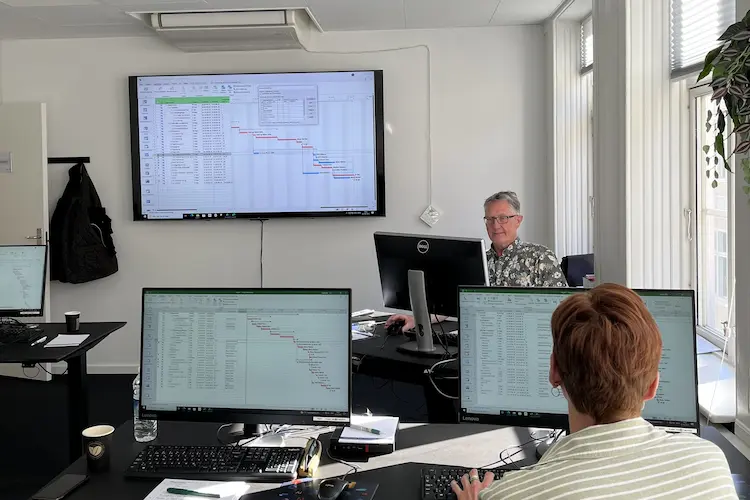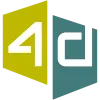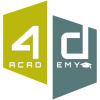Kursusmål
This course provides the knowledge and skills to design and implement DevOps processes and practices. Students will learn how to plan for DevOps, use source control, scale Git for an enterprise, consolidate artifacts, design a dependency management strategy, manage secrets, implement continuous integration, implement a container build strategy, design a release strategy, set up a release management workflow, implement a deployment pattern, and optimize feedback mechanisms.Deltagere
Students in this course are interested in implementing DevOps processes or in passing the Microsoft Azure DevOps Solutions certification exam.Skills gained
- Plan for the transformation with shared goals and timelines
- Select a project and identify project metrics and KPIs
- Create a team and agile organization structure
Prerequisites
Fundamental knowledge about Azure, version control, Agile software development, and core software development principles. It would be helpful to have experience in an organization that delivers software.
Kursusmateriale
Før kurset- Mulighed for at tale med en instruktør, der kan hjælpe dig med at finde det helt rigtige kursus.
- Undervisning af Danmarks mest erfarne instruktørteam i hyggelige og fuldt opdaterede kursuslokaler i centrum af København.
- Et kursus bestående af en vekslen mellem teori og praktiske øvelser. Vi ved, hvor vigtigt det er, at du får tid til at arbejde med opgaverne i praksis, og derfor har vi altid fokus på hands-on i undervisningen.
- Et kursusmateriale, som du efterfølgende kan bruge som opslagsværk samt et opgavesæt, der understøtter kurset.
- Fuld forplejning, som inkluderer morgenmad, friskbrygget kaffe, te, frugt, sodavand, frokost på en italiensk restaurant på Gråbrødretorv, kage, slik, og naturligvis Wi-Fi til dine devices.
- Et kursuscertifikat med bevis på dine nye kvalifikationer.
- Adgang til vores gratis hotline, som betyder, at du op til et år efter kurset kan ringe eller skrive til os, hvis du har spørgsmål til de emner, der er blevet gennemgået på kurset.
- Vores unikke tilfredshedsgaranti, som er din tryghed for at få fuldt udbytte af dit kursus.
Kurset bliver afholdt på dansk, men vi benytter Microsofts digitale materiale (DMOC), som er på engelsk.
Du vil efterfølgende have adgang til materialet både online og lokalt. I tilfælde af at Microsoft laver en ny version af kursusmaterialet, vil du automatisk få adgang til det. Derudover vil du have adgang til øvelser via Microsoft Labs Online i 180 dage i alt, og du kan derfor fortsætte eller starte forfra på en øvelse hjemmefra, under eller efter kurset, alt efter behov.materialet både online og lokalt. I tilfælde af at Microsoft laver en ny version af kursusmaterialet, vil du automatisk få adgang til det
Kursusindhold
Module 1: Get started on a DevOps transformation journey
Lessons
- Introduction to DevOps
- Choose the right project
- Describe team structures
- Choose the DevOps tools
- Plan Agile with GitHub Projects and Azure Boards
- Introduction to source control
- Describe types of source control systems
- Work with Azure Repos and GitHub
Lab : Agile planning and portfolio management with Azure Boards
Lab : Version controlling with Git in Azure Repos
After completing this module, students will be able to:
- Understand what DevOps is and the steps to accomplish it
- Identify teams to implement the process
- Plan for the transformation with shared goals and timelines
- Plan and define timelines for goals
- Understand different projects and systems to guide the journey
- Select a project to start the DevOps transformation
- Identify groups to minimize initial resistance
- Identify project metrics and Key Performance Indicators (KPI's)
- Understand agile practices and principles of agile development
- Create a team and agile organizational structure
Module 2: Development for enterprise DevOps
Lessons
- Structure your Git Repo
- Manage Git branches and workflows
- Collaborate with pull requests in Azure Repos
- Explore Git hooks
- Plan foster inner source
- Manage Git repositories
- Identify technical debt
Lab : Version controlling with Git in Azure Repos
After completing this module, students will be able to:
- Understand Git repositories
- Implement mono repo or multiple repos
- Explain how to structure Git Repos
- Implement a change log
- Describe Git branching workflows
- Implement feature branches
- Implement GitFlow
- Fork a repo
- Leverage pull requests for collaboration and code reviews
- Give feedback using pull requests
Module 3: Implement CI with Azure Pipelines and GitHub Actions
Lessons
- Explore Azure Pipelines
- Manage Azure Pipeline agents and pools
- Describe pipelines and concurrency
- Explore Continuous integration
- Implement a pipeline strategy
- Integrate with Azure Pipelines
- Introduction to GitHub Actions
- Learn continuous integration with GitHub Actions
- Design a container build strategy
Lab : Configuring agent pools and understanding pipeline styles
Lab : Enabling continuous integration with Azure Pipelines
Lab : Integrating external source control with Azure Pipelines
Lab : Implementing GitHub Actions by using DevOps Starter
Lab : Deploying Docker Containers to Azure App Service web apps
After completing this module, students will be able to:
- Describe Azure Pipelines
- Explain the role of Azure Pipelines and its components
- Decide Pipeline automation responsibility
- Understand Azure Pipeline key terms
- Choose between Microsoft-hosted and self-hosted agents
- Install and configure Azure pipelines Agents
- Configure agent pools
- Make the agents and pools secure
- Use and estimate parallel jobs
Module 4: Design and implement a release strategy
Lessons
- Introduction to continuous delivery
- Explore release strategy recommendations
- Build a high-quality release pipeline
- Introduction to deployment patterns
- Implement blue-green deployment and feature toggles
- Implement canary releases and dark launching
- Implement A/B testing and progressive exposure deployment
Lab : Creating a release dashboard
Lab : Controlling deployments using Release Gates
After completing this module, students will be able to:
- Explain continuous delivery (CD)
- Implement continuous delivery in your development cycle
- Understand releases and deployment
- Identify project opportunities to apply CD
- Explain things to consider when designing your release strategy
- Define the components of a release pipeline and use artifact sources
- Create a release approval plan
- Implement release gates
- Differentiate between a release and a deployment
Module 5: Implement a secure continuous deployment using Azure Pipelines
Lessons
- Create a release pipeline
- Provision and test environments
- Manage and modularize tasks and templates
- Automate inspection of health
- Manage application configuration data
- Integrate with identity management systems
- Implement application configuration
Lab : Configuring pipelines as code with YAML
Lab : Setting up and running functional tests
Lab : Integrating Azure Key Vault with Azure DevOps
After completing this module, students will be able to:
- Explain the terminology used in Azure DevOps and other Release Management Tooling
- Describe what a Build and Release task is, what it can do, and some available deployment tasks
- Implement release jobs
- Differentiate between multi-agent and multi-configuration release job
- Provision and configure target environment
- Deploy to an environment securely using a service connection
- Configure functional test automation and run availability tests
- Setup test infrastructure
- Use and manage task and variable groups
Module 6: Manage infrastructure as code using Azure and DSC
Lessons
- Explore infrastructure as code and configuration management
- Create Azure resources using Azure Resource Manager templates
- Create Azure resources by using Azure CLI
- Explore Azure Automation with DevOps
- Implement Desired State Configuration (DSC)
- Implement Bicep
Lab : Azure deployments using Azure Resource Manager templates
After completing this module, students will be able to:
- Understand how to deploy your environment
- Plan your environment configuration
- Choose between imperative versus declarative configuration
- Explain idempotent configuration
- Create Azure resources using ARM templates
- Understand ARM templates and template components
- Manage dependencies and secrets in templates
- Organize and modularize templates
- Create Azure resources using Azure CLI
Module 7: Implement security and validate code bases for compliance
Lessons
- Introduction to Secure DevOps
- Implement open-source software
- Software Composition Analysis
- Static analyzers
- OWASP and Dynamic Analyzers
- Security Monitoring and Governance
Lab : Implement security and compliance in Azure Pipelines
Lab : Managing technical debt with SonarQube and Azure DevOps
After completing this module, students will be able to:
- Identify SQL injection attack
- Understand DevSecOps
- Implement pipeline security
- Understand threat modeling
- Implement open-source software
- Explain corporate concerns for open-source components
- Describe open-source licenses
- Understand the license implications and ratings
- Work with Static and Dynamic Analyzers
- Configure Microsoft Defender for Cloud
Module 8: Design and implement a dependency management strategy
Lessons
- Explore package dependencies
- Understand package management
- Migrate, consolidate, and secure artifacts
- Implement a versioning strategy
- Introduction to GitHub Packages
Lab : Package management with Azure Artifacts
After completing this module, students will be able to:
- Define dependency management strategy
- Identify dependencies
- Describe elements and componentization of a dependency management
- Scan your codebase for dependencies
- Implement package management
- Manage package feed
- Consume and create packages
- Publish packages
- Identify artifact repositories
- Migrate and integrate artifact repositories
Module 9: Implement continuous feedback
Lessons
- Implement tools to track usage and flow
- Develop monitor and status dashboards
- Share knowledge within teams
- Design processes to automate application analytics
- Manage alerts, Blameless retrospectives and a just culture
Lab : Monitoring application performance with Application Insights
Lab : Integration between Azure DevOps and Microsoft Teams
Lab : Sharing Team Knowledge using Azure Project Wikis
After completing this module, students will be able to:
- Implement tools to track feedback
- Plan for continuous monitoring
- Implement Application Insights
- Use Kusto Query Language (KQL)
- Implement routing for mobile applications
- Configure App Center Diagnostics
- Configure alerts
- Create a bug tracker
- Configure Azure Dashboards
- Work with View Designer in Azure Monitor
Tilmeld kurset
Har du spørgsmål sidder vi klar til at hjælpe på vores live chat eller via kontaktsiden
Status
Startdato
Hvad siger vores kunder om os?
1242
Evalueringer seneste år
4,8
Gns. Rating ud af 5
Siden 1990 har 4D Academy hjulpet virksomheder og specialister med at omsætte viden til målbare resultater. Vores kursister belønner os med en gennemsnitlig rating på 4,8 ud af 5 på Trustpilot, Google og Facebook, og det gør os stolte.
Se hvorfor både nye og erfarne fagfolk vælger os, når de vil løfte deres kompetencer.
Hold dig opdateret med vores nyhedsbrev
Her bor vi
Hovedindgang
Læderstræde 22-26, 2. sal
1201 København K
1201 København K
Kursusindgang
Læderstræde 22-26, 2. sal
1201 København K
1201 København K
Åbningstider
Mandag: 08.00 - 16.00
Tirsdag: 08.00 - 16.00
Onsdag: 08.00 - 16.00
Torsdag: 08.00 - 16.00
Fredag: 08.00 - 16.00
Tirsdag: 08.00 - 16.00
Onsdag: 08.00 - 16.00
Torsdag: 08.00 - 16.00
Fredag: 08.00 - 16.00





